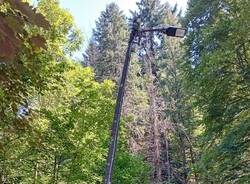In the laboratories of Insubria University, the structures of DNA are being studied, to design oncotherapeutic drugs
Researchers at the Universities of Insubria (in Varese), Milan-Bicocca and Padua, in collaboration with the CNR-IFN, have analysed how the secondary structures of DNA, present in some protooncogene promoters, evolve. The studies have been published in Nucleic Acids Research.

The aim is to observe, close up, the behaviour of the G-quadruplex, the secondary structures of DNA, to help in designing new-generation oncotherapeutic drugs. The results of the studies, which were carried out by researchers at the Universities of Insubria, Milan-Bicocca and Padua, in collaboration with the Institute for Photonics and Nanotechnologies of the National Research Council (CNR-IFN), were brought together in two works published in the journal Nucleic Acids Research (DOI: 10.1093/nar/gkab079 – 10.1093/nar/gkab674).
When we think of DNA, the structure that immediately comes to mind is the double helix. For years, however, it has been known that DNA can locally form unconventional structures. A particularly significant aspect is that these systems represent interesting means of therapeutic intervention in the treatment of many diseases, including tumours, neurodegenerative diseases, infections, etc. The unconventional secondary structures called G-quartets (G4s) occupy a significant position in this context thanks to their particular functional importance. To date, the research of new drugs, which are directed at the aforementioned targets, has not produced the desired results and this comes largely from the fact that the DNA structure changes considerably in time and space.
The researchers analysed the conformational and nanomechanical features of the G4s present in the promoter of a particular protooncogene responsible for many types of tumour, combining ensemble methods and measurements of individual molecules, to understand how these structures evolve over time, how the double-helix DNA matrix that surrounds them influences their evolution, and how they interact when they form near one another. Moreover, they observed that the presence of sequences capable of forming G4s in a segment of DNA, can induce the nanomechanical denaturation of the double helix in it, and therefore the beginning of the gene expression. Since the proteins responsible for DNA transcription (the process that starts the protein synthesis) work by exerting forces and torsions on the promoters to induce local denaturation, the information collected provides a high definition “picture” of the selected target. Finally, it was possible to observe how these sequences bend and how fast they do so. This information will help to design new-generation drugs that control the production of oncoproteins in cancer patients.
“This collaboration has been between researchers who are geographically far apart, but involved in a sort of delocalised laboratory, who are able to create non-commercial innovative equipment and to apply it to the characterisation of biological samples which have been designed ad hoc. All of this is possible thanks also to the support of our University Institutions which allow and facilitate this networking,” said Dr Luca Nardo of the Science and High Technology Department of Insubria University.
“The research was carried out with an interdisciplinary approach, with the joint involvement of biophysicists and pharmaceutical chemists. Indeed, only by means of a close collaboration among researchers who belong to scientific communities that traditionally interact only marginally, and who are willing to share complementary skills, is it possible to provide answers to questions that seem unsolvable. In particular, it was necessary to measure individual molecules on DNA strands, which were literally studied one by one in order to characterise aspects that are generally hidden by ensemble measurements,” said Professor Francesco Mantegazza, of the Medicine and Surgery Department of the University of Milan-Bicocca.
“The fundamental contribution of our results is that of strongly emphasising to the scientific community that it is necessary to understand the evolution in time and space of the targets we want to hit in order to intervene in an effective and targeted way. By involving scientists with apparently different views, our network enabled us to respond to this need, developing innovative and versatile approaches which can now be used on a wider scale,” said Professor Claudia Sissi of the Department of Pharmaceutical Sciences of Padua University.
“As the head of the Laboratory of Photophysics and Biomolecules in Como, which is shared by the CNR and Insubria, I’m extremely satisfied with the important results obtained in recent years, and with this, in particular. I thank all the young researches who have worked in the laboratory, without whose dedication and expertise this research would have been impossible,” concluded Professor Maria Bondani of the CNR-IFN.
Translated by Tea Bernasconi and Nicole Dall’Osto
Reviewed by prof. Rolf Cook
La community di VareseNews
Loro ne fanno già parte
Ultimi commenti
Emanuele Zanetti su Motociclista di Samarate ucciso da un orso in Romania
GrandeFratello su Superate le 700 firme per la petizione sul recupero del Grand Hotel Campo dei Fiori di Varese
Felice su Motociclista di Samarate ucciso da un orso in Romania
Stefano64 su Neil Young torna dopo l'enorme successo di Harvest: ma non è il disco che tutti si aspettano
Alessandro Zanzi su Superate le 700 firme per la petizione sul recupero del Grand Hotel Campo dei Fiori di Varese
Felice su La bibliocabina, la panchina e il cane che fa pipì. A Fagnano Olona scoppia la polemica
















Accedi o registrati per commentare questo articolo.
L'email è richiesta ma non verrà mostrata ai visitatori. Il contenuto di questo commento esprime il pensiero dell'autore e non rappresenta la linea editoriale di VareseNews.it, che rimane autonoma e indipendente. I messaggi inclusi nei commenti non sono testi giornalistici, ma post inviati dai singoli lettori che possono essere automaticamente pubblicati senza filtro preventivo. I commenti che includano uno o più link a siti esterni verranno rimossi in automatico dal sistema.